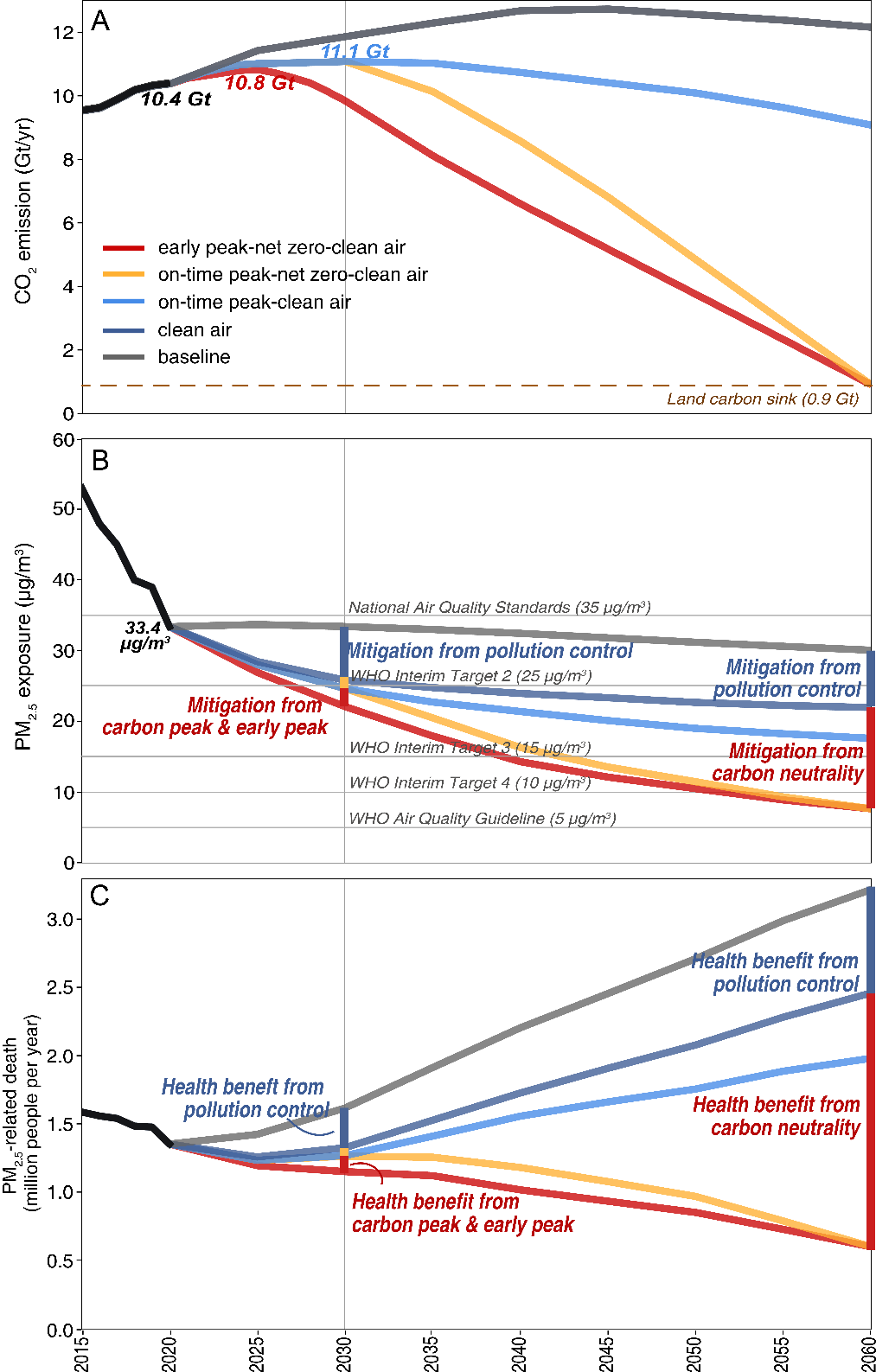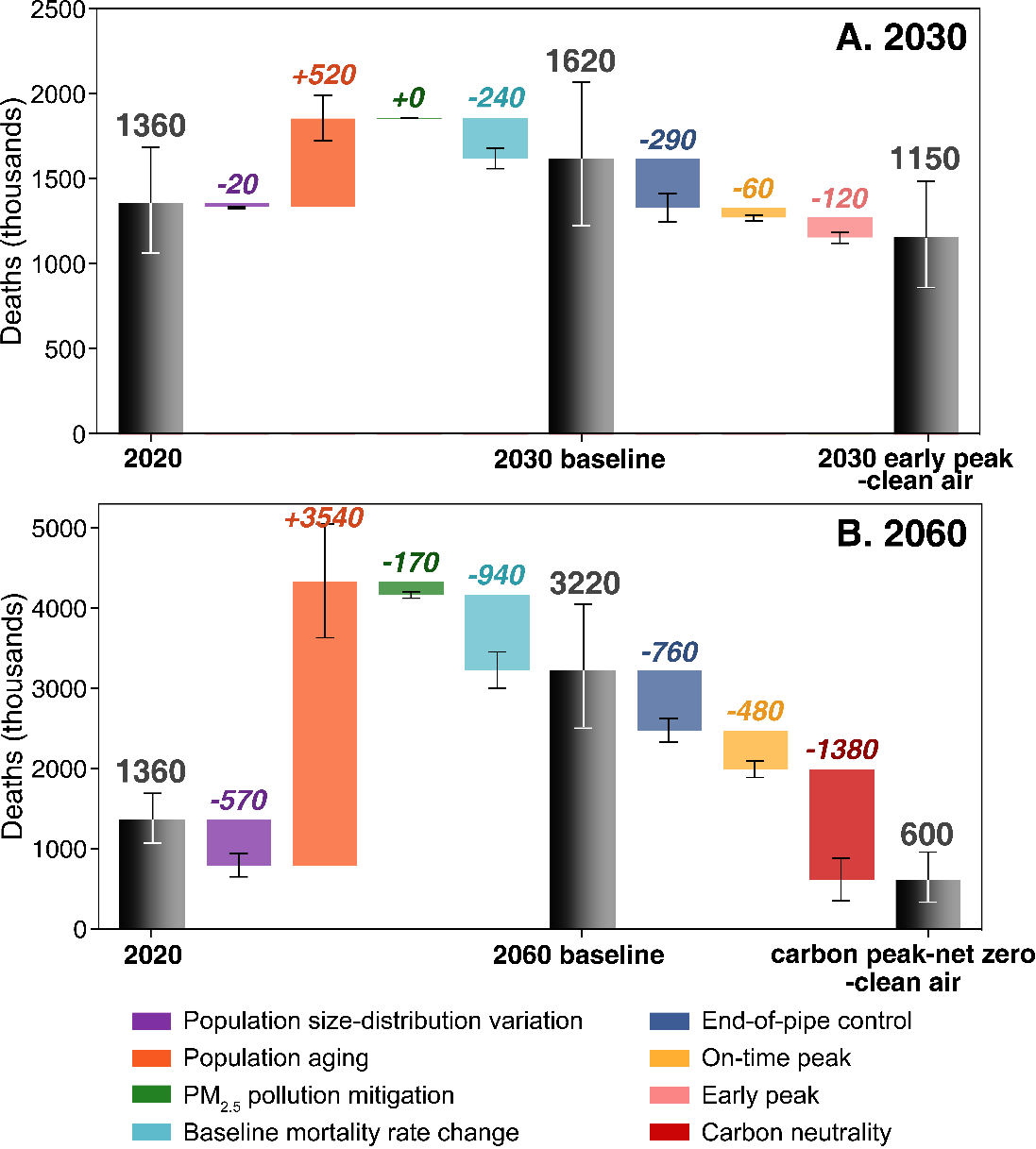China has made significant progress in alleviating air pollution since 2013, but the annual mean fine particulate matter (PM2.5) concentration remains six times higher than current World Health Organization (WHO) guidelines, seriously compromising public health. Meanwhile, the aging population will be increasingly vulnerable to air pollution, lending urgency further and constant air quality improvements. Since greenhouse gases and air pollutants are often co-emitted, a synergistic approach to climate mitigation and clean air action may deliver considerable health benefits. Since the proposal of the goals of carbon peaking and carbon neutrality in 2020, the implementation of a synergistic approach to carbon neutrality and clean air policies has become a major policy choice for China’s further improvements of air quality.
Against these backdrops, Zhang Qiang’s Research Group of the Department of Earth System Science (DESS), Tsinghua University has, based on the independently developed China Carbon Neutrality and Clean Air synergetic Platform (CNCAP), designed five groups of emission reduction pathways with different strengths and made a comparative analysis of the changes of future air quality and related health losses under each pathway, revealing the considerable health benefits generated by the implementation of the synergistic approach of carbon neutrality and clean air in China from 2020 to 2060, and quantitatively analyzed the future promotion of air quality improvement and reduction of pollution-related health losses through a series of combined scenario analysis on different periods and regions. The above research results have been published online in One Earth, a journal under Cell Press, as a paper titled “A synergistic approach to air pollution control and carbon neutrality in China can avoid millions of premature deaths annually by 2060”.
It has been found in this study that with the synergistic approach to carbon neutrality and clean air policies, China’s emissions will drop to 0.9 Gt in 2060, and national population-weighted mean PM2.5 concentrations in this pathway will be reduced from 33.4 μg/m3 in 2020 to 7.6 μg/m3 in 2060, lower than the WHO IT-4 in 2060. Compared with the benchmark scenario, by implementing a synergistic approach to carbon neutrality and clean air policies, 2.62 million premature deaths could be eliminated by 2060. Limited by technical maturity and cost, it is difficult to implement energy and industrial transformation measures on a large scale in the short term, and end-of-pipe control measures will continue to play a leading role before 2030. After 2030, with the gradual implementation of energy and industrial transformation measures, carbon neutrality policy will become the main driver for continuously improving air quality and reducing pollution and health losses (Fig. 2). Meanwhile, it has been found that the implementation of differentiated collaborative governance measures according to the characteristics of energy endowment and industrial structure in different regions is a necessary guarantee for benefiting people's livelihood and maximally protecting public health.

Fig. 1. China’s carbon emissions, PM2.5 exposure, and changes in the number of related premature deaths under different future scenarios

Fig. 2. Drivers of national PM2.5-related premature deaths in different future periods
The datasets of the dynamic projection model for emissions in China [DPEC (DPEC v1.2)] supporting the above study can be downloaded from the MEIC website (http://meicmodel.org.cn), and the simulated data of China’s future PM2.5 concentrations can be downloaded from the CNCAP platform website (http://cncap.org.cn). To reasonably delineate the future changes of atmospheric composition emissions in China under the coordinated pathway of carbon peaking, carbon neutrality and clean air policies, Professor Zhang Qiang's Research Group has cooperated with the GCAM model team of the Northwest Pacific National Laboratory in the United States, and deeply participated in the development of the GCAM-China model. On the one hand, the model structure has been improved, and the multi-sectoral and multi-industry carbon neutrality technical route has been described in detail. On the other hand, the GCAM-China model has been coupled with the Multi-Scale Emission Inventory Model of China (MEIC), and a method combining the bottom-up technological succession model with the top-down optimization model has been established, solving the problem that the comprehensive evaluation model is too early and too fast to simulate the emission pathways of carbon peaking in China in the near and medium terms under the low emission pathway, thus realizing the reasonable projection of the emission pathway in the near and medium term.
Cheng Jing, a doctoral graduate of the DESS (currently postdoctoral fellow of the University of California, Irvine, and Prof. Zhang Qiang of the DESS is the paper’s corresponding author. Paper collaborators include Prof. Tong Dan of the DESS, Dr. Liu Yang, Associate Researcher Geng Guannan, and Academician He Kebin of the School of Environment, Tsinghua University, and Prof. Steven Davis of the University of California, Irvine. The study was supported by the National Natural Science Foundation of China, the Energy Foundation, and the New Cornerstone Science Foundation .
Full-text link of the paper: https://www.cell.com/one-earth/fulltext/S2590-3322(23)00341-X
Written by Cheng Jing
Edited by Wang Jiayin
Reviewed by Geng Rui